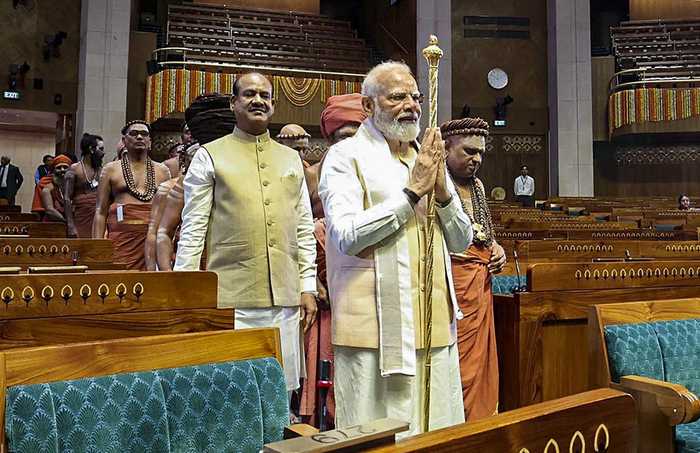Published 09:08 IST, June 27th 2024
'Sengol' Politics Back Again: INDI Bloc MP Demands Its Removal from Parliament, BJP Retorts
Samajwadi Party MP on Wednesday ignited a political firestorm after making a demand for the removal of 'Sengol' from the Lok Sabha.
- India News
- 2 min read
New Delhi: Samajwadi Party MP on Wednesday ignited a political firestorm after making a demand for the removal of 'Sengol' from the Lok Sabha, calling it an anachronistic symbol of monarchy in a democratic India.
Mohanlalganj MP RK Chaudhary said, “The Constitution is the symbol of democracy. In its previous tenure, the BJP govt under the leadership of PM Modi installed 'Sengol' in Parliament. 'Sengol' means 'Raj-Dand'. It also means 'Raja ka Danda'."
"After ending the princely order, the country became independent. Will the country be run by 'Raja ka danda' or the Constitution?”
He further claimed that he sought the removal of ‘Sengol’ from Parliament to save the Constitution. Staging protest after taking oath as MP in the 18th Lok Sabha, Chaudhary also submitted a letter to pro-tem Speaker Bhartruhari Mahtab questioning the presence of Sengol next to the Speaker's chair.
BJP Hits Back
Hitting back at the Samajwadi Party, a key constituent of the INDI bloc, the BJP said that the Akhilesh Yadav-led party never hesitates to launch an attack on Indian culture and traditions.
BJP leader Shehzad Poonawalla said, “Samajwadi party never hesitates to attack the Indian Sanskriti. They say Sengol should be removed from Parliament which is an insult to Tamil Nadu.”
He further asked whether DMK and its leader MK Stalin would accept such an insult of the Sengol that comes from Tamil Nadu.
“Will DMK accept such an insult? The state of Tamil Nadu is getting its well-deserved respect but Samajwadi Party is opposing it. They are disrespecting the Tamil and Indian culture in the open.”
Sengol In New Parliament
Prime Minister Narendra Modi installed the sacred ‘Sengol’ from Tamil Nadu in the Lok Sabha, right next to the Speaker's chair, in the new Parliament after performing the rituals in May last year.

It was the same Sengol that India's first Prime Minister Jawaharlal Nehru accepted at his residence on the night of August 14, in the presence of several Indian and British leaders.
Derived from the Tamil word 'semmai,' meaning 'righteousness,' the historical sceptre known as 'Sengol' has captured attention in recent days. According to popular belief, the Adheenam of Tamil Nadu presented the 'Sengol' to Jawaharlal Nehru in August 1947, symbolizing the transfer of power from the British to the Indian people.
Updated 13:11 IST, June 27th 2024